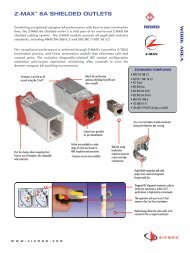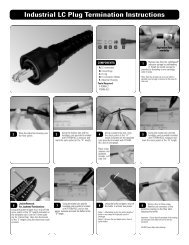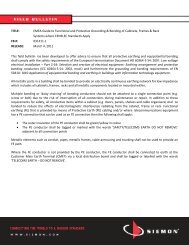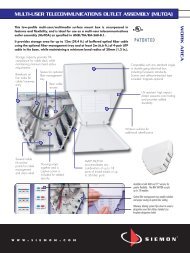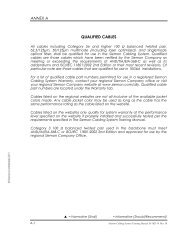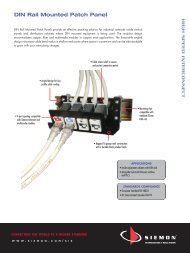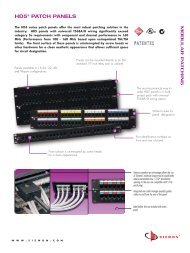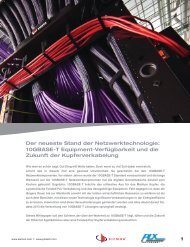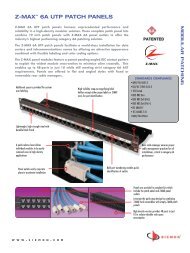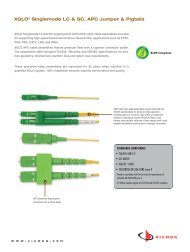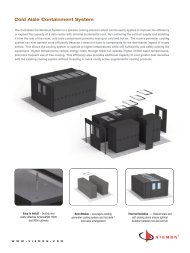SIEMON SYSTEM CATALOG
SIEMON SYSTEM CATALOG
SIEMON SYSTEM CATALOG
Create successful ePaper yourself
Turn your PDF publications into a flip-book with our unique Google optimized e-Paper software.
GLOSSARY<br />
Alien Crosstalk: Noise or interference caused by electromagnetic coupling<br />
from one cable to another cable, expressed in decibels.<br />
Attenuation: See Insertion Loss.<br />
Attenuation to Crosstalk Ratio (ACR): The difference between insertion<br />
loss and crosstalk measured in decibels.<br />
Attenuation to Crosstalk Ratio, Far-end (ACR-F): Crosstalk measured at<br />
the opposite end from which the disturbing signal is transmitted, normalized<br />
by the insertion loss of the cable or cabling.<br />
Backbone Cabling: Cable and connecting hardware that comprise the main<br />
and intermediate cross-connects, as well as cable runs that extend between<br />
telecommunications rooms, equipment rooms and entrance facilities.<br />
Balance An indication of signal voltage equality and phase polarity on a<br />
conductor pair. Perfect balance occurs when the signals across a twistedpair<br />
are equal in magnitude and opposite in phase with respect to ground.<br />
Balanced Signal Transmission: Two voltages, equal and opposite in phase<br />
with respect to each other, across the conductors of a twisted-pair (commonly<br />
referred to as tip and ring).<br />
Balun: An impedance matching transformer used to convert unbalanced<br />
signals to balanced signals and vice versa.<br />
Bandwidth: A range of frequencies, usually the difference between the<br />
upper and lower limits of the range, typically expressed in megahertz (MHz).<br />
It may also be used to describe the information-carrying capacity of a<br />
medium. Optical fiber bandwidth is specified in megahertz kilometers (MHzkm).<br />
Bonding: The permanent joining of metallic parts to form an electrically<br />
conductive path that will assure electrical continuity and the capacity to conduct<br />
safely any current likely to be imposed on it.<br />
Bridged Tap: The multiple appearances of the same cable pair or fiber at<br />
several distribution points. Also known as parallel connections.<br />
Bridging: A means of providing through connections between conductors or<br />
pairs that are terminated on connecting blocks. These through connections<br />
are commonly provided by means of individual metallic “bridging” clips or<br />
multiple “bridging” clips that are housed in a plastic insulator.<br />
Building Distributor (BD): The international term for intermediate crossconnect.<br />
A distributor in which the building backbone cable(s) terminates and<br />
at which connections to the campus backbone cable(s) may be made.<br />
Bundled Cable: An assembly of two or more cables continuously bound together<br />
to form a single unit prior to installation (sometimes referred to as<br />
loomed, speed-wrap or whip cable constructions).<br />
Cabling: A combination of cables, wire, cords and connecting hardware used<br />
in the telecommunications infrastructure.<br />
Campus Backbone: Cabling between buildings that share telecommunications<br />
facilities.<br />
Campus Distributor (CD): The international term for main cross-connect.<br />
The distributor from which the campus backbone cable emanates.<br />
Category:<br />
1. ANSI/TIA/568-C series of documents, the North American standards<br />
for cabling describes mechanical properties and transmission characteristics<br />
of balanced cabling components and assigns a unique<br />
number classification (category 3, category 5e,<br />
category 6 and category 6A).<br />
2. ISO/IEC 11801 2nd edition, the international standard for cabling<br />
and local standardization documents define cabling component categories<br />
based on transmission performance parameters such as attenuation<br />
and NEXT loss, over a specified frequency range.<br />
Component categories category 5, category 6, category 6 A<br />
category 7 and category 7 A .<br />
Channel: The end-to-end transmission path connecting any two points at<br />
which application specific equipment is connected. Equipment and work<br />
area cables are included in the channel.<br />
Classification: Application classes for cabling have been identified for the<br />
purpose of the ISO/IEC 11801 standard;<br />
– Class A: cabling is characterized up to 100 kHz<br />
– Class B: cabling is characterized up to 1 MHz<br />
– Class C: cabling is characterized up to 16 MHz<br />
– Class D: cabling is characterized up to 100 MHz<br />
– Class E: cabling is characterized up to 250 MHz<br />
– Class E A : cabling is characterized up to 500 MHz<br />
– Class F: cabling is characterized up to 600 MHz<br />
– Class F A : cabling is characterized up to 1000 MHz<br />
– Optical Class: optical fiber links are characterized from 10 MHz and<br />
above.<br />
Collapsed Backbone: A centralized network contained in one device.<br />
The network is said to be collapsed and made to fit into a box. Individual<br />
networks are connected to this central device and can then communicate<br />
with one another.<br />
Common Mode Transmission: A transmission scheme where voltages appear<br />
equal in magnitude and phase across a conductor pair with respect to<br />
ground. May also be referred to as longitudinal mode.<br />
Consolidation Point (CP): A location for interconnection between horizontal<br />
cables that extend from building pathways and horizontal cables that extend<br />
into work area pathways.<br />
Cross-connect: A facility enabling the termination of cables as well as their<br />
interconnection or cross-connection with other cabling or equipment. Also<br />
known as a distributor.<br />
Cross-connection: A connection scheme between cabling runs, subsystems<br />
and equipment using patch cords or jumpers that attach to connecting hardware<br />
on each end.<br />
Crosstalk: Noise or interference caused by electromagnetic coupling from<br />
one signal path to another. Crosstalk performance is generally expressed in<br />
decibels.<br />
Decibel (dB): A standard unit for expressing transmission gain or loss as<br />
derived from a ratio of signal voltages or power.<br />
Delay Skew: The difference in propagation delay between the fastest and<br />
slowest pair in a cable or cabling system.<br />
Demarcation Point (DP): A point at which two services may interface and<br />
identify the division of responsibility.<br />
Differential Mode Transmission: A transmission scheme where voltages<br />
appear equal in magnitude and opposite in phase across a twisted-pair with<br />
respect to ground. May also be referred to as balanced mode.<br />
Distributor: The term used for the functions of a collection of components<br />
(e.g. patch panels, patch-cords) used to interconnect cables.<br />
Electromagnetic Compatibility (EMC): The ability of a system to minimize<br />
radiated emissions and maximize immunity from external noise sources.<br />
Electromagnetic Interference (EMI): The interference in signal transmission<br />
or reception caused by the radiation of electrical and magnetic fields.<br />
Entrance Facility (EF): An entrance to a building for both public and private<br />
network service cables (including antennae), including the entrance point at<br />
the building wall and continuing to the entrance room or space. Entrance facilities<br />
are often used to house electrical protection equipment and connecting<br />
hardware for the transition between outdoor and indoor cable.<br />
13.0 www.siemon.com



